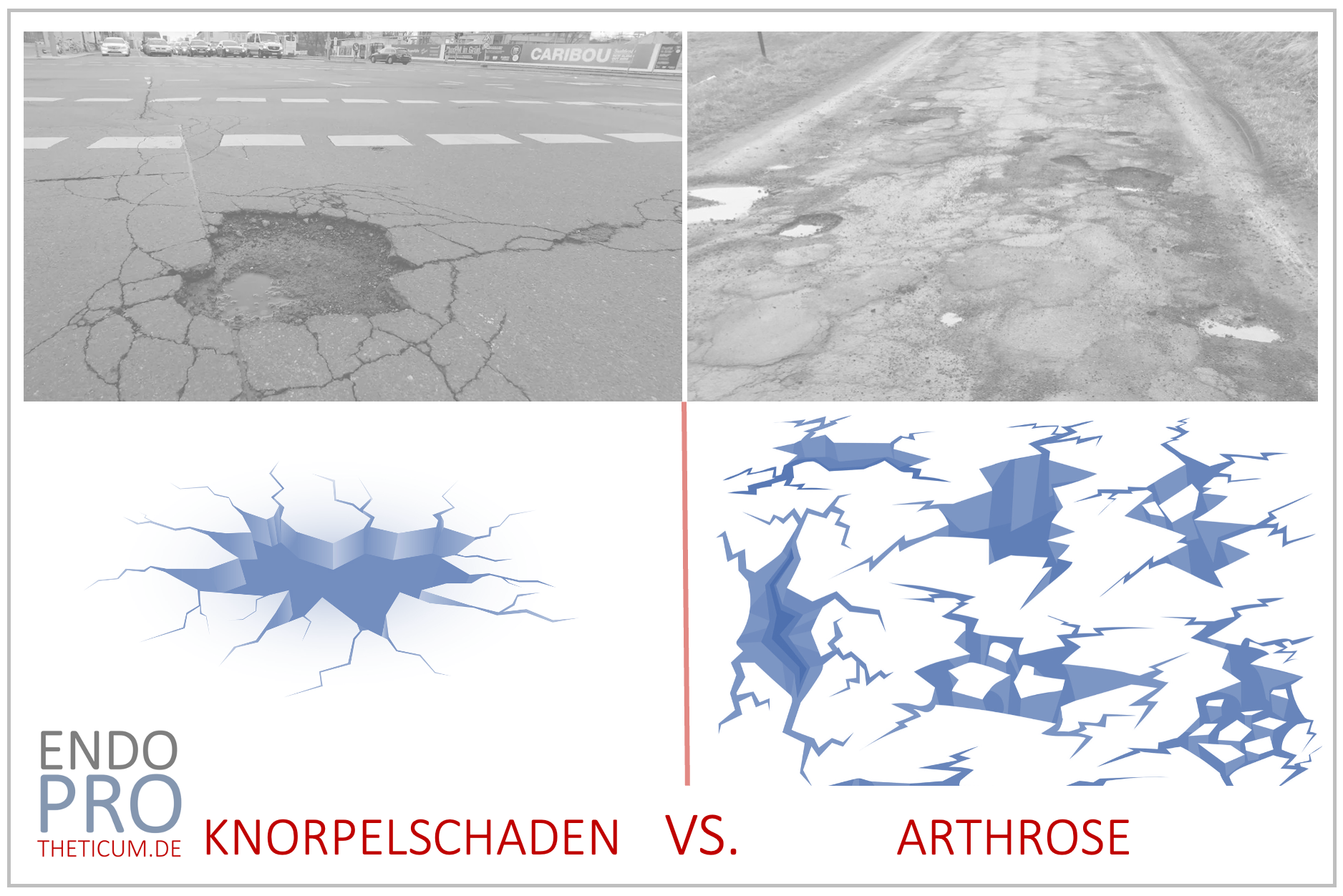Cartilage damage or osteoarthritis – what are the differences?
Why differentiating between cartilage damage and osteoarthritis is so important.

Cartilage damage and osteoarthritis are terms that are often mentioned in the same breath when it comes to joint diseases. However, there are significant differences between these two conditions, affecting both their causes and treatment. In this comprehensive blog, we examine the differences between cartilage damage and osteoarthritis, particularly focusing on the hip and knee joints. We will also explain in detail the possible treatment options for cartilage damage or osteoarthritis.
What is cartilage damage?
Definition and development Cartilage damage describes a localized injury or wear and tear of the articular cartilage, which acts as a protective layer covering the joint surfaces. The causes can be traumatic in nature, for example due to sports accidents, or degenerative due to long-term overuse.
Types of cartilage damage
- Traumatic damage: Direct injury caused by accidents.
- Degenerative damage: Slow wear and tear due to aging or incorrect loading.
Symptoms
- Pain with movement or exertion.
- Mechanical limitations.
- Joint swelling or effusions.
What is osteoarthritis?
Definition and course of the disease Osteoarthritis is a chronic, degenerative disease characterized by the progressive, extensive loss of articular cartilage. While cartilage damage is a localized problem, osteoarthritis is a systemic wear-and-tear disease that affects the entire joint.
causes
- Primary osteoarthritis: Without clear triggering factors, often age-related.
- Secondary osteoarthritis: As a result of injuries, misalignments or metabolic diseases.
Symptoms
- Start-up pain after periods of rest.
- Stress pain that becomes permanent pain over time.
- Joint stiffness and deformation of the affected joint.
Differences between cartilage damage and osteoarthritis
Cartilage damage and osteoarthritis differ fundamentally in their cause, their course and the therapeutic options. However, these terms are often confused.
Cartilage damage is a focal, often acute or subacute, damage to the articular cartilage, usually caused by specific trauma, overuse or diseases such as osteochondritis. This type of damage usually affects younger people or people who are active in sports and is often limited to a clearly defined region in the joint. Early and targeted therapeutic approaches, such as cartilage smoothing, microfracturing or cartilage transplantation, can repair the damaged area and completely restore joint function. Cartilage damage is therefore potentially reversible, especially in the early stages.
Osteoarthritis , on the other hand, is a chronic, degenerative joint disease that is associated with a continuous and irreversible breakdown of the cartilage layer. It develops over years, often as a result of long-term incorrect loading, obesity, genetic predisposition or age-related wear and tear. In contrast to localized cartilage damage, osteoarthritis often affects the entire joint, including the bones, the joint capsule and the surrounding muscles. This leads to persistent pain, restricted movement and, in advanced stages, irreversible joint changes.
While cartilage damage offers a good chance of recovery with appropriate treatment, therapy for osteoarthritis is primarily aimed at slowing progression and relieving symptoms. Measures such as physiotherapy, weight loss or pain-relieving injections are usually useful, but in severe cases joint replacement is often the last and most effective option. In summary, cartilage damage is a potentially reversible, local problem, while osteoarthritis is a more extensive and chronic joint disease that is associated with irreversible consequences.
Cartilage damage to the knee joint
Common causes
- Injuries such as cruciate ligament tears.
- Chronic incorrect loading, for example due to bow or knock knees.
Symptoms in the knee area
- Pain when flexing or stretching.
- Blockages caused by loose pieces of cartilage.
Diagnosis
- X-rays do not show any details - this is where an MRI is crucial.
- Arthroscopy to view the cartilage damage.
Therapy options
- Conservative treatment: physiotherapy, painkillers.
- Surgical interventions: microfactoring, autologous chondrocyte transplantation (ACT).
- Hyaluronic acid injections: Improve joint lubrication.
Osteoarthritis of the knee joint (gonarthrosis)
Special features The knee is one of the most commonly affected joints in osteoarthritis because it is exposed to high loads. What is typical is the gradual loss of articular cartilage, which in later stages leads to bone-on-bone friction.
Symptoms
- Chronic pain that increases as the disease progresses.
- Stiffness and deformation of the joint.
Therapy options
- Early stage: weight control, moderate exercise, nutritional supplements.
- Late stage: knee arthroplasty (TEP).
Cartilage damage to the hip joint
Special features Cartilage damage in the hip joint often occurs due to misalignment or trauma. If left untreated, these can lead to coxarthrosis.
Symptoms
- Pain in the groin area.
- Restrictions on movement, for example when climbing stairs.
Therapy options
- Infiltrations: Pain reduction through cortisone or hyaluronic acid.
- Surgical repair: cartilage replacement procedure or Pridie drilling.
Osteoarthritis of the hip joint (coxarthrosis)
Origin and progression Coxarthrosis affects the hip joint and often begins gradually. The degenerative disease causes the cartilage layer to decrease, causing bones to rub against each other.
Symptoms
- Deep groin pain.
- Shortened stride length when walking.
Therapy options
- Non-surgical: medication, physical therapy, weight loss.
- Surgical: total endoprosthesis (TEP).
Prevention – what can you do?
Promote cartilage health
- Regular exercise that is gentle on the joints (e.g. swimming or cycling).
- Anti-inflammatory diet with omega-3 fatty acids.
- Avoiding excess weight.
Regular checks Early diagnosis helps to prevent progressive cartilage damage.
Conclusion
Cartilage damage and osteoarthritis are two different conditions that require different treatment approaches. Cartilage damage is an acute or subacute, often localized damage to the articular cartilage caused by trauma, overuse or specific diseases. This damage is reversible in many cases, especially with timely and targeted treatment such as cartilage repair or transplantation. In contrast, osteoarthritis is a chronic, progressive breakdown of cartilage, which usually occurs as a result of aging processes or long-term incorrect loading. Osteoarthritis affects the entire joint, causes permanent damage and is irreversible. While cartilage damage affects younger, active people, osteoarthritis typically occurs in older people. Therapeutically, the treatment of cartilage damage is aimed at restoring the cartilage, whereas in advanced osteoarthritis often only a joint replacement can provide lasting pain relief and improved function. Accurate diagnosis and an individually tailored therapy plan are crucial to maintaining joint health and relieving pain in the long term. Thanks to modern medical advances, there are now many ways to significantly improve quality of life despite joint damage.
MAKE AN APPOINTMENT?
You are welcome to make an appointment either by phone or online .



























